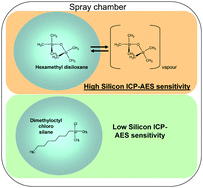Silicon is present in petrol products under very different chemical forms. The effect of the silicon chemical form on the sensitivity was studied by inductively coupled plasma atomic emission spectrometry (ICP-AES). Solutions containing sixteen different silicon organic compounds with the same silicon concentration were prepared in xylene. The studied compounds were: six siloxanes, nine silanes and a silicate. Their boiling points ranged from 101 °C (hexamethyldisiloxane) to 310 °C (2,3,4-(epoxycyclohexyl)ethyltrimetoxysilane). The results indicated that the ICP-AES signal depended strongly on the silicon compound. Thus, for a commonly used sample introduction system consisting of a cross-flow pneumatic nebulizer coupled to a Ryton double pass spray chamber, the signal varied by a factor of up to 17, depending on the compound. For most studied cases, some siloxanes yielded higher emission intensities than silanes. In addition, under some circumstances, hexylmethyldichlorosilane and dimethyldodecylchlorosilane also produced higher signals than the other studied silanes. In order to elucidate the possible mechanisms for these changes, a series of experiments was performed to verify whether the origin could be assigned either to the plasma or to the sample introduction system. Using the Mg II/Mg I ratio, no significant change in the plasma characteristics was actually observed. As regards the sample introduction system, (i) the primary aerosol, (ii) the transport and memory effects using continuous and discrete introduction modes, an alternative spray chamber, and a total consumption system (the TISIS system), and (iii) the tertiary aerosol, via an impactor, were studied. Additional experiments were carried out with an ultrasonic nebulizer. In addition, the Si behaviour was compared to other elements, such as Cu, Mg, Mn and Zn. The results indicated that the Si behaviour was not related to the pneumatic nebulizer and suggested that a fraction of silicon was transported towards the plasma as a vapour when it was present as hexamethyldisiloxane (i.e., the compound with the lowest boiling point among the species studied). In any case, the variability of the signal induced by the different silicon chemical forms was less significant for the TISIS than for cyclonic and ultrasonic nebulizer. The observed results were specific to silicon as the signal of the other elements did not significantly change with silicon chemical form. As a consequence, internal standardization was not appropriate for mitigating interferences on silicon when petroleum products were analyzed.


 Please wait while we load your content...
Please wait while we load your content...